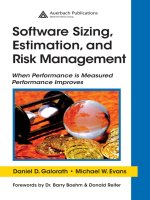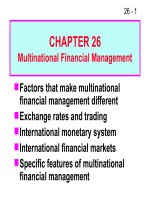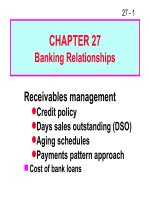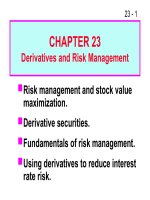FM11 Ch 11 Cash Flow Estimation and Risk Analysis
Bạn đang xem bản rút gọn của tài liệu. Xem và tải ngay bản đầy đủ của tài liệu tại đây (130.57 KB, 57 trang )
11 - 1
Estimating cash flows:
Relevant cash flows
Working capital treatment
Inflation
Risk Analysis: Sensitivity Analysis,
Scenario Analysis, and Simulation
Analysis
CHAPTER 11
Cash Flow Estimation and Risk
Analysis
11 - 2
Cost: $200,000 + $10,000 shipping +
$30,000 installation.
Depreciable cost $240,000.
Economic life = 4 years.
Salvage value = $25,000.
MACRS 3-year class.
Proposed Project
11 - 3
Annual unit sales = 1,250.
Unit sales price = $200.
Unit costs = $100.
Net operating working capital
(NOWC) = 12% of sales.
Tax rate = 40%.
Project cost of capital = 10%.
11 - 4
Incremental Cash Flow for a Project
Project’s incremental cash flow is:
Corporate cash flow with the
project
Minus
Corporate cash flow without the
project.
11 - 5
NO. We discount project cash flows with
a cost of capital that is the rate of return
required by all investors (not just
debtholders or stockholders), and so we
should discount the total amount of cash
flow available to all investors.
They are part of the costs of capital. If
we subtracted them from cash flows, we
would be double counting capital costs.
Should you subtract interest expense
or dividends when calculating CF?
11 - 6
NO. This is a sunk cost. Focus on
incremental investment and
operating cash flows.
Suppose $100,000 had been spent last
year to improve the production line
site. Should this cost be included in
the analysis?
11 - 7
Yes. Accepting the project means we
will not receive the $25,000. This is
an opportunity cost and it should be
charged to the project.
A.T. opportunity cost = $25,000 (1 - T)
= $15,000 annual cost.
Suppose the plant space could be
leased out for $25,000 a year. Would
this affect the analysis?
11 - 8
Yes. The effects on the other
projects’ CFs are “externalities”.
Net CF loss per year on other lines
would be a cost to this project.
Externalities will be positive if new
projects are complements to existing
assets, negative if substitutes.
If the new product line would decrease
sales of the firm’s other products by
$50,000 per year, would this affect the
analysis?
11 - 9
Basis = Cost
+ Shipping
+ Installation
$240,000
What is the depreciation basis?
11 - 10
Year
1
2
3
4
%
0.33
0.45
0.15
0.07
Depr.
$ 79.2
108.0
36.0
16.8
x Basis =
Annual Depreciation Expense (000s)
$240
11 - 11
Annual Sales and Costs
Year 1 Year 2 Year 3
Year 4
Units 1250 1250 1250
1250
Unit price $200 $206 $212.18
$218.55
Unit cost $100 $103 $106.09
$109.27
Sales $250,000 $257,500 $265,225
$273,188
Costs $125,000 $128,750 $132,613
$136,588
11 - 12
Why is it important to include inflation
when estimating cash flows?
Nominal r > real r. The cost of capital,
r, includes a premium for inflation.
Nominal CF > real CF. This is because
nominal cash flows incorporate
inflation.
If you discount real CF with the higher
nominal r, then your NPV estimate is
too low.
Continued…
11 - 13
Inflation (Continued)
Nominal CF should be discounted
with nominal r, and real CF should be
discounted with real r.
It is more realistic to find the nominal
CF (i.e., increase cash flow estimates
with inflation) than it is to reduce the
nominal r to a real r.
11 - 14
Operating Cash Flows (Years 1 and 2)
Year 1
Year 2
Sales $250,000
$257,500
Costs $125,000
$128,750
Depr. $79,200
$108,000
EBIT $45,800
$20,750
Taxes (40%) $18,320
$8,300
NOPAT $27,480
$12,450
+ Depr. $79,200
$108,000
Net Op. CF $106,680
$120,450
11 - 15
Operating Cash Flows (Years 3 and 4)
Year 3
Year 4
Sales $265,225
$273,188
Costs $132,613
$136,588
Depr. $36,000
$16,800
EBIT $96,612
$119,800
Taxes (40%) $38,645
$47,920
NOPAT $57,967
$71,880
+ Depr. $36,000
$16,800
Net Op. CF $93,967
$88,680
11 - 16
Cash Flows due to Investments in Net
Operating Working Capital (NOWC)
NOWC
Sales (% of sales)
CF
Year 0 $30,000 -
$30,000
Year 1 $250,000 $30,900 -
$900
Year 2 $257,500 $31,827 -
$927
Year 3 $265,225 $32,783 -
$956
Year 4 $273,188
$32,783
11 - 17
Salvage Cash Flow at t = 4 (000s)
Salvage value
Tax on SV
Net terminal CF
$25
(10)
$15
11 - 18
What if you terminate a project before
the asset is fully depreciated?
Cash flow from sale = Sale proceeds
- taxes paid.
Taxes are based on difference between
sales price and tax basis, where:
Basis = Original basis - Accum. deprec.
11 - 19
Original basis = $240.
After 3 years = $16.8 remaining.
Sales price = $25.
Tax on sale = 0.4($25-$16.8)
= $3.28.
Cash flow = $25-$3.28=$21.72.
Example: If Sold After 3 Years (000s)
11 - 20
Net Cash Flows for Years 1-3
Year 0 Year 1
Year 2
Init. Cost -$240,000 0
0
Op. CF 0 $106,680
$120,450
NOWC CF -$30,000 -$900
-$927
Salvage CF 0 0
0
Net CF -$270,000 $105,780
$119,523
11 - 21
Net Cash Flows for Years 4-5
Year 3
Year 4
Init. Cost 0 0
Op CF $93,967
$88,680
NOWC CF -$956
$32,783
Salvage CF 0
$15,000
Net CF $93,011
$136,463
11 - 22
Project Net CFs on a Time Line
Enter CFs in CFLO register and I = 10.
NPV = $88,030.
IRR = 23.9%.
0 1 2 3 4
(270,000) 105,780 119,523 93,011 136,463
11 - 23
What is the project’s MIRR? (000s)
(270,000)
MIRR = ?
0 1 2 3 4
(270,000) 105,780 119,523 93,011
136,463
102,312
144,623
140,793
524,191
11 - 24
1. Enter positive CFs in CFLO:
I = 10; Solve for NPV = $358,029.581.
2. Use TVM keys: PV = -358,029.581,
N = 4, I = 10; PMT = 0; Solve for FV =
524,191. (TV of inflows)
3. Use TVM keys: N = 4; FV = 524,191;
PV = -270,000; PMT= 0; Solve for
I = 18.0.
MIRR = 18.0%.
Calculator Solution
11 - 25
What is the project’s payback?
(000s)
Cumulative:
Payback = 2 + 44/93 = 2.5 years.
0 1 2 3 4
(270)*
(270)
106
(164)
120
(44)
93
49
136
185









